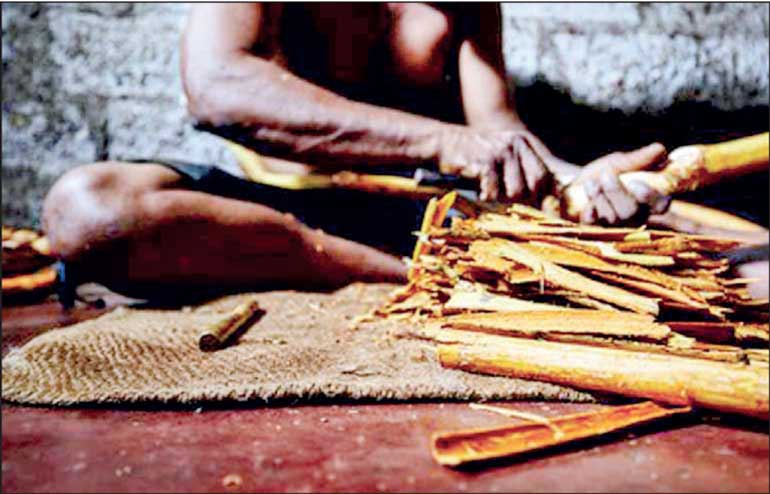Monday Dec 29, 2025
Monday Dec 29, 2025
Saturday, 16 August 2025 00:20 - - {{hitsCtrl.values.hits}}

 |
| ACCPGI Secretary Christopher Fernando |
By Charumini de Silva
Association for Ceylon Cinnamon Protected Geographical Indication (ACCPGI) Secretary Christopher Fernando said the global market for Ceylon Cinnamon is experiencing a period of robust growth, driven by increasing consumer demand for natural health-enhancing ingredients and premium quality spices.
“Amid shifting global preferences, Ceylon Cinnamon continues to distinguish itself, carving out a significant niche in both traditional and emerging industries. The Geographical Identification (GI) status to protect the authenticity of Pure Ceylon Cinnamon is now getting in the international markets,” he told the Daily FT.
He said the cinnamon exports in the first six months of 2024 increased from $ 76.24 million to $ 95.3 million, up by 25% year-on-year (YoY).
Fernando disclosed that the rise of e-commerce had also expanded the global reach of Ceylon Cinnamon, enabling niche producers and exporters to tap into diverse consumer bases. “Online platforms are making it easier for small-scale suppliers to showcase their products, especially in retail forms like oils, powdered spice packs, and functional food ingredients,” he said.
According to him, Sri Lanka remains at the heart of this booming market, accounting for an estimated 80-90% of the world’s production and exports of true cinnamon. “As a key agricultural export and a major foreign exchange earner, cinnamon holds strategic importance in the country’s economy, with key export markets including Europe, North America, Middle East, East Asia and Pacific, Latin America, Africa, and South Asia as major markets,” he added.
Fernando said 2,500 kilos of Cinnamon as a value-added retail pack was successfully shipped to the EU market by Samagi Spice Exports Ltd., a company under the Ceylon Cinnamon GI tag, this month—the largest quantity of GI-Cinnamon exported as a value-added retail pack from Sri Lanka to-date.
As per the latest export figures released by the Export Development Board (EDB), export earnings from spices and essential oils increased by 29.64% YoY to $ 208.53 million during the first half of 2025. This increase was due to the strong performance in exports of pepper (26.86%), cinnamon (25.01%), and cloves (277.67%).
As of January 2024, 78 farmers and processors were formally recognised as meeting GI requirements—they became the first certified GI-Ceylon Cinnamon growers in Sri Lanka. The EDB and Cinnamon Development Department are overseeing expansion of membership and regulation through the ACCPGI.
“We proposed that the EDB establish a system to track the annual volume and value of GI-certified cinnamon exports, including the format—retail or otherwise. As the GI certificate holder, the EDB could issue shipment certificates, possibly with Customs’ support. All GI-certified exporters should be listed on the EDB website to boost visibility and encourage others. Greater awareness, promotion, and traceability, led by the EDB and Cinnamon Department, are key to expanding certified plantations and exports,” Fernando added.
He noted that the overall cinnamon market is valued between $ 1.06 billion and 1.4 billion in 2024, which included both Ceylon Cinnamon and cassia varieties. “Industry forecasts estimate market growth to reach between $ 1.5 billion and $ 2.52 billion by 2033, with compound average growth rates (CAGR) ranging from 3.08% to 7.83%. “Within this market, Ceylon Cinnamon accounts for a sizeable 36% to 37% share and is expected to maintain a steady growth trajectory at a CAGR of around 6.1%,” Fernando said.
Noting that Ceylon Cinnamon offers the country a powerful avenue to boost export earnings and elevate its global brand, Fernando stressed that continued innovation, sustainability, and strategic marketing will be critical to ensuring that Sri Lanka retains its competitive edge in this flourishing segment of the global spice trade.
He noted that consumer awareness of Ceylon Cinnamon’s health benefits is a key growth driver as scientific studies and wellness trends continue to highlight the spice’s antioxidant, anti-inflammatory, and antitumor properties. “Unlike cassia, cinnamon is viewed as a safer, natural alternative for long-term consumption. This distinction is especially important to health-conscious consumers in North America and Europe, where demand for organic and sustainably sourced products is steadily rising,” he pointed out.
In addition to its health profile, Fernando explained Ceylon Cinnamon’s superior quality and delicate, sweet flavour, which makes it highly priced in the culinary world.
“Ceylon Cinnamon is increasingly used in premium food and beverage products, including bakery goods, confectionery, savoury recipes, and speciality teas. Beyond the kitchen, its antimicrobial and therapeutic properties have led to its growing use in the pharmaceutical, cosmetic, and even animal feed industries,” he added.